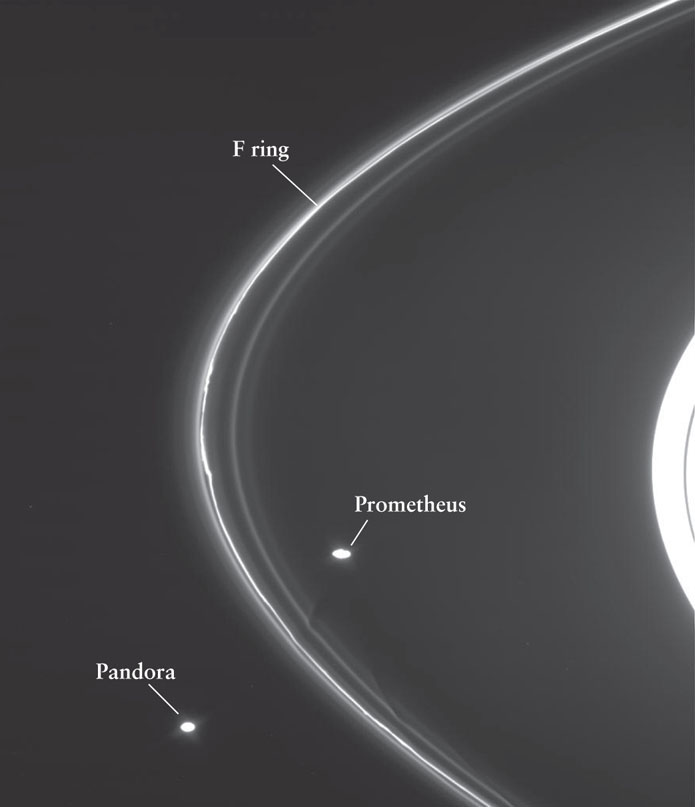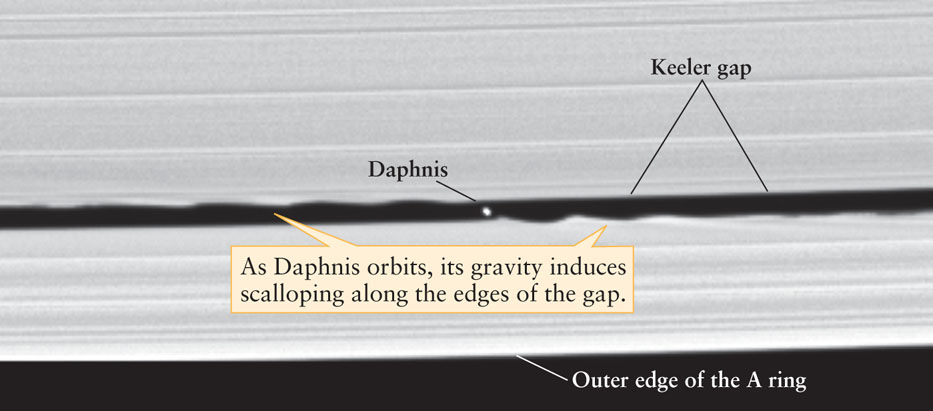12-11 Saturn’s inner satellites affect the appearance and structure of its rings
Why do Saturn’s rings have such a complex structure? The answer is that, like any object in the universe, the particles that make up the rings are affected by the force of gravity. Saturn’s gravitational pull keeps the ring particles in orbit around the planet. But the satellites of Saturn also exert gravitational forces on the rings. These forces can shape the orbits of the ring particles and help give rise to the rings’ structure.
Resonance and Shepherd Satellites
An arrangement in which one orbiting object has twice the orbital period of another is called an orbital resonance. (More generally, an orbital resonance occurs whenever the orbital periods of two objects are related by a ratio of small integers.) In an orbital resonance, gravitational interactions occur with just the right rhythm to transfer the greatest amount of energy. As an analogy, you naturally push someone on a swing in resonance with the swing’s motion; in this way a little energy is added with each push, and the swing gets very high with repeated pushes. Now let’s see how the Cassini division results from an orbital resonance.

Saturn’s F Ring and Its Two Shepherds This Cassini image shows the tiny satellites Prometheus (102 km across) and Pandora (84 km across). (Compare with Figure 12-20.) These orbit Saturn on either side of its F ring, shepherding the ring particles into a narrow band. The satellites lap each other every 25 days.
Astronomers have long known that one of Saturn’s moons, Mimas, has a gravitational effect on Saturn’s ring system. Mimas is a moderate-sized satellite that orbits Saturn every 22.6 hours. According to Kepler’s third law, ring particles in the Cassini division—if they existed—would orbit Saturn approximately every 11.3 hours. Consequently, a given set of ring particles in the Cassini division would find itself between Saturn and Mimas on every second orbit (that is, every 22.6 hours). In other words, particles in the Cassini division are in a 2-to-1 orbital resonance with Mimas. Because of these repeated alignments, the combined gravitational forces of Saturn and Mimas cause small particles to deviate from their original orbits, sweeping them out of the Cassini division. This helps explain why the Cassini division is relatively empty (although not completely so, as Figure 12-21 shows).
While Mimas tends to spread ring particles apart, other satellites exert gravitational forces that herd particles together. Cassini observed two such satellites orbiting on either side of the narrow F ring (Figure 12-25). Pandora, the outer of the two satellites, moves around Saturn at a slightly slower speed than the particles in the ring. As ring particles pass Pandora, they experience a tiny gravitational tug that slows them down slightly. Hence, these particles lose a little energy and fall into orbits a bit closer to Saturn. At the same time, Prometheus, the inner satellite, orbits the planet somewhat faster than the F ring particles. The gravitational pull of Prometheus makes the ring particles speed up a little, giving them some extra energy and nudging them into slightly higher orbits. The competition between the pulls exerted by these two satellites focuses the F ring particles into a well-defined, narrow band.
Because of their confining influence, Prometheus and Pandora are called shepherd satellites. We will see in Chapter 14 that Uranus is encircled by narrow rings that are likewise kept confined by shepherd satellites.
Gravitational effects carve gaps in the rings and focus ring particles into narrow ringlets
An effect similar to shepherding explains two divisions in the A ring, the Encke gap and the even narrower Keeler gap (Figure 12-20). In 2005, Cassini images revealed a miniature moon, Daphnis, which actually orbits inside the Keeler gap (Figure 12-26). In a fashion similar to the F ring’s shepherds, Daphnis’s gravitational forces cause ring particles outside its orbit to move farther out and cause those inside its orbit to move farther inward toward Saturn. In this way, Daphnis helps to maintain a gap in the rings that is 42 km (26 mi) wide, many times wider than Daphnis’s 7-km (4-mi) diameter. In a similar way, a 20-km wide moon called Pan orbits within and maintains the 270-km wide Encke gap. Both of these moons cause wavelike disturbances in the ring material on either side of the gap through which they travel (see Figure 12-25).

 Daphnis and the Keeler Gap This Cassini spacecraft shows Saturn’s tiny moon Daphnis orbiting within the Keeler gap (see also Figure 12-20). Although it is just 7 km across, Daphnis exerts enough gravitational force to keep the 42-km wide gap open and induce wavelike disturbances in the two edges of the gap.
Daphnis and the Keeler Gap This Cassini spacecraft shows Saturn’s tiny moon Daphnis orbiting within the Keeler gap (see also Figure 12-20). Although it is just 7 km across, Daphnis exerts enough gravitational force to keep the 42-km wide gap open and induce wavelike disturbances in the two edges of the gap.
In addition to their dynamic ring systems, Jupiter and Saturn together have an exotic collection of moons. These include Saturn’s moon Titan, with a thick atmosphere rich in hydrocarbons; Jupiter’s satellite Io, the most volcanic world in the solar system; and Saturn’s satellite Enceladus, which has exotic geysers that spew a mixture of water vapor and ice. We will examine these alien worlds in Chapter 13.
CONCEPT CHECK 12-11
If Saturn’s moon Mimas orbited somewhat farther than it currently does, how would this affect the Cassini division?
The Cassini division is created by a destabilizing 2-to-1 orbital resonance with Saturn’s moon Mimas. Due to this resonance, repeated gravitational tugs clear out any particles at this location. If Mimas orbited farther away, its period would increase, and the Cassini division would appear farther out as well (where its dislodged particles also had a larger period).